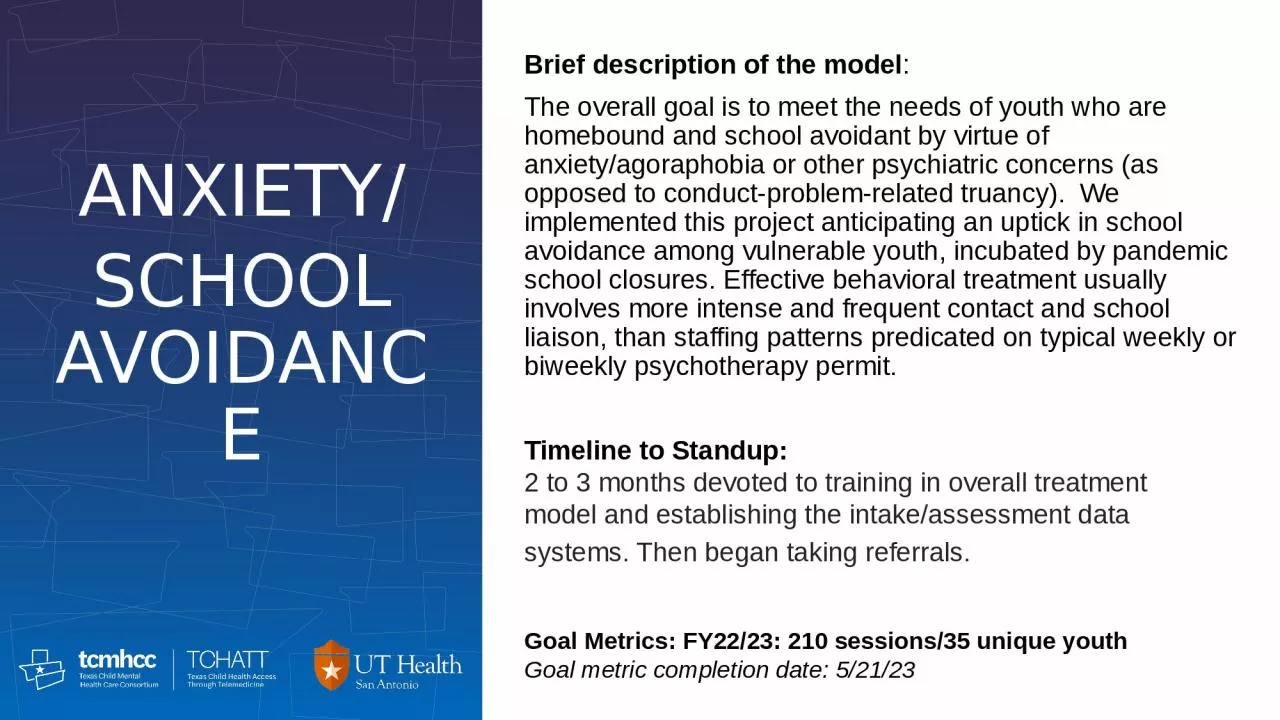

Brief description of the model The overall goal is to meet the needs of youth who are homebound and school avoidant by virtue of anxietyagoraphobia or other psychiatric concerns as opposed to conductproblemrelated truancy We implemented this project anticipating an uptick in school av ID: 1033752
Download Presentation The PPT/PDF document "ANXIETY/ SCHOOL AVOIDANCE" is the property of its rightful owner. Permission is granted to download and print the materials on this web site for personal, non-commercial use only, and to display it on your personal computer provided you do not modify the materials and that you retain all copyright notices contained in the materials. By downloading content from our website, you accept the terms of this agreement.
1. ANXIETY/SCHOOL AVOIDANCEBrief description of the model: The overall goal is to meet the needs of youth who are homebound and school avoidant by virtue of anxiety/agoraphobia or other psychiatric concerns (as opposed to conduct-problem-related truancy). We implemented this project anticipating an uptick in school avoidance among vulnerable youth, incubated by pandemic school closures. Effective behavioral treatment usually involves more intense and frequent contact and school liaison, than staffing patterns predicated on typical weekly or biweekly psychotherapy permit. Timeline to Standup:2 to 3 months devoted to training in overall treatment model and establishing the intake/assessment data systems. Then began taking referrals. Goal Metrics: FY22/23: 210 sessions/35 unique youthGoal metric completion date: 5/21/23
2. Impact so far…Average number of sessions per child: 6Typical duration of care: 10 to 12 SessionsTotal Referrals: 59 to dateUnique Patients Enrolled: 50Unique Sessions Provided: 310Currently Active Patients: 40Lost to Follow Up and Drop Out: 1Successfully Completed Treatment: 2 Currently monitoring students throughout the summer to assess progress with reintegration into the new school year on the path to successful discharge.
3. Parent Feedback-"Thank you so much, I didn't think your techniques or suggestions would work but they did! My son is doing so much better because of his therapy." -"Thank you so much for all you have done to help us. My daughter is now going to school with no problem!"
4. Hurdles and ChallengesParent engagement and participationCoordination with school counselor to liaisonLimits of in vivo exposures Scheduling with families (desired frequency of sessions 1 to 2x per week + check-ins)Commitment for client to return to in-person schoolingDelay in referral stream gaining momentumInitial assessment data has been complicated or time consuming on occasion Occasionally, homebound school-avoidance develops among youngsters with more severe psychiatric issues. There are very few suitable day-treatment programs for these students. The few that do exist lack a school program. Point of Contact: Dr. Joseph Blader, Ph.D. blader@uthscsa.edu